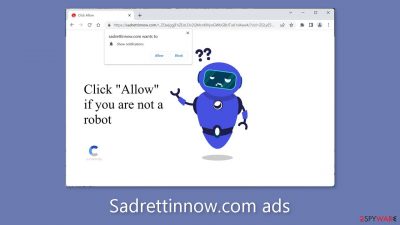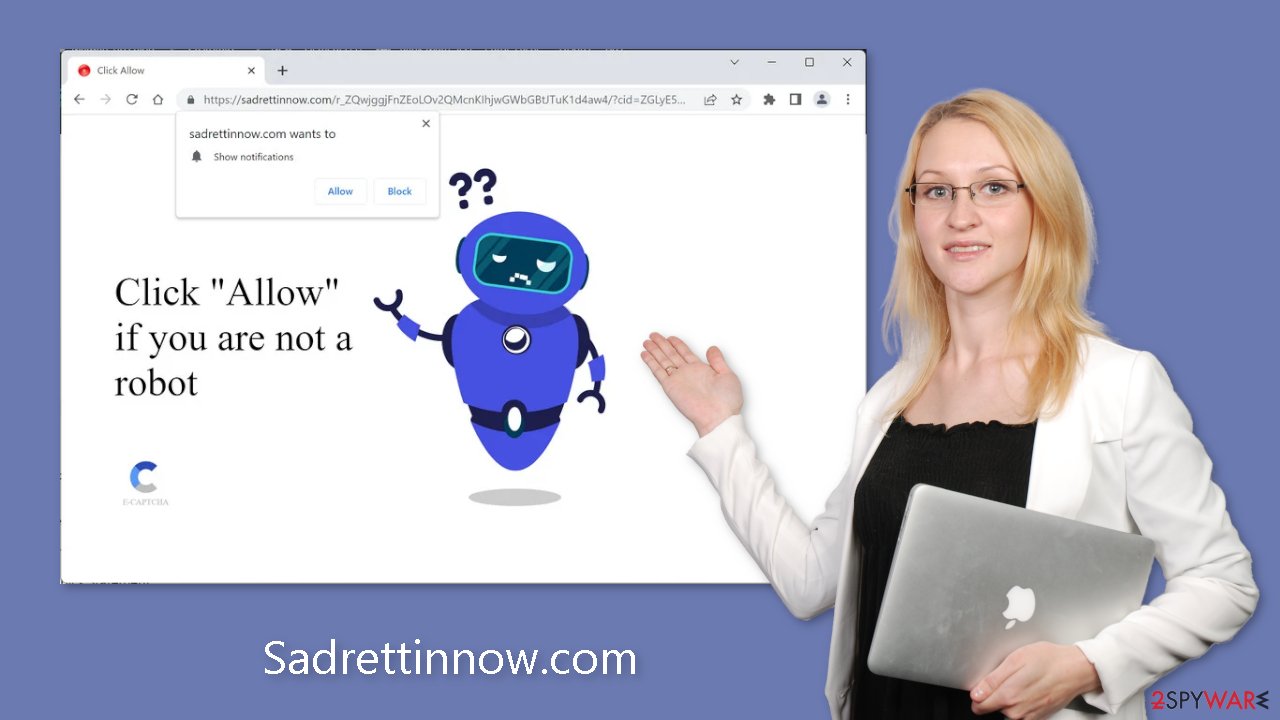Sadrettinnow.com ads (fake) - Free Guide
Sadrettinnow.com ads Removal Guide
What is Sadrettinnow.com ads?
Sadrettinnow.com is a site created by crooks that use social engineering to trick people

At first glance, Sadrettinnow.com appears to be a captcha verification process, but it is actually a fraudulent website designed by crooks to exploit user activity for monetary gain. It tricked people into clicking the “Allow” button to confirm their non-robot status, but in reality, they unknowingly subscribed to push notifications. The webpage dupes users using social engineering techniques.
As a result, users are bombarded with intrusive pop-up advertisements, which may even appear after they close their browsers. Unfortunately, these advertisements may be generated by unethical advertising networks that direct users to dangerous websites. Individuals may unintentionally land on scam pages promoting bogus antivirus software, software deals, bogus giveaways, and bogus surveys.
As a result, fraudsters may gain access to personal information, and users may unknowingly install potentially unwanted programs (PUPs)[1] and malware. While push notification spam is not a virus, it can cause serious problems if users are not cautious.
| NAME | Sadrettinnow.com |
| TYPE | Push notification spam; adware |
| SYMPTOMS | Pop-up ads start appearing in the corner of the screen |
| DISTRIBUTION | Shady websites, deceptive ads, freeware installations |
| DANGERS | The ads can contain links leading to dangerous websites where users could get tricked into providing their personal information or downloading PUPs and malware |
| ELIMINATION | Go to your browser settings to disable notifications |
| FURTHER STEPS | Use a maintenance tool FortectIntego to get rid of any remaining damage and clear your browsers |
Distribution methods
Sadrettinnow.com pages are rarely found in search results. They typically lurk on unregulated and dubious websites. Illegal streaming platforms,[2] for example, are notorious for hosting deceptive advertisements and hidden redirects that can lead users to dangerous websites.
It is critical to avoid clicking on random links and buttons. Instead, only go to websites that you know are safe. Choose legitimate streaming services over illegal streaming platforms, as the latter are breeding grounds for various types of malware. Be wary of fake “Download” and “Play” buttons on torrent sites and peer-to-peer file-sharing platforms.

Software bundling
Push notification spam pages may appear without user interaction at times. This can happen if your device is infected with adware.[3] Adware is software that is funded by advertising revenue, which is typically generated through pay-per-click advertisements. It can take the form of pop-ups, banners, or redirects.
When using freeware distribution platforms, users frequently inadvertently install adware. To generate revenue, these platforms frequently bundle additional programs within their installers. However, not all bundled software is safe and can cause a variety of problems. It is critical to use caution during the installation process or to download software from official web stores and developer websites.
We recommend using the “Custom” or “Advanced” installation methods and reading the Privacy Policy and Terms of Service carefully. Pay close attention to the file list and uncheck any unrelated apps to prevent their installation by unchecking the corresponding boxes.
Remove browser pop-ups
To get rid of intrusive pop-up ads, you have to go to your browser settings and block the permission manually. The process is quite simple, as we show below:
Google Chrome (desktop):
- Open Google Chrome browser and go to Menu > Settings.
- Scroll down and click on Advanced.
- Locate the Privacy and security section and pick Site Settings > Notifications.
![Stop notifications on Chrome PC 1 Stop notifications on Chrome PC 1]()
- Look at the Allow section and look for a suspicious URL.
- Click the three vertical dots next to it and pick Block. This should remove unwanted notifications from Google Chrome.
![Stop notifications on Chrome PC 2 Stop notifications on Chrome PC 2]()
Google Chrome (Android):
- Open Google Chrome and tap on Settings (three vertical dots).
- Select Notifications.
- Scroll down to Sites section.
- Locate the unwanted URL and toggle the button to the left (Off setting).
![Stop notifications on Chrome Android Stop notifications on Chrome Android]()
Mozilla Firefox:
- Open Mozilla Firefox and go to Menu > Options.
- Click on Privacy & Security section.
- Under Permissions, you should be able to see Notifications. Click Settings button next to it.
![Stop notifications on Mozilla Firefox 1 Stop notifications on Mozilla Firefox 1]()
- In the Settings – Notification Permissions window, click on the drop-down menu by the URL in question.
- Select Block and then click on Save Changes. This should remove unwanted notifications from Mozilla Firefox.
![Stop notifications on Mozilla Firefox 2 Stop notifications on Mozilla Firefox 2]()
Safari:
- Click on Safari > Preferences…
- Go to Websites tab and, under General, select Notifications.
- Select the web address in question, click the drop-down menu and select Deny.
![Stop notifications on Safari Stop notifications on Safari]()
MS Edge:
- Open Microsoft Edge, and click the Settings and more button (three horizontal dots) at the top-right of the window.
- Select Settings and then go to Advanced.
- Under Website permissions, pick Manage permissions and select the URL in question.
![Stop notifications on Edge 1 Stop notifications on Edge 1]()
- Toggle the switch to the left to turn notifications off on Microsoft Edge.
![Stop notifications on Edge 2 Stop notifications on Edge 2]()
MS Edge (Chromium):
- Open Microsoft Edge, and go to Settings.
- Select Site permissions.
- Go to Notifications on the right.
- Under Allow, you will find the unwanted entry.
- Click on More actions and select Block.
![Stop notifications on Edge Chromium Stop notifications on Edge Chromium]()
Get rid of cookies and cache
It is strongly advised to avoid dubious pages that are involved in illegal activities. Cookies may be used on these pages to track your IP address and geolocation. Websites can also collect information about your browsing habits, such as the websites you visit, your online searches, and your online purchases.
Cookies and cache, which are small data files stored on your system, can slow down your device's performance. After you've taken steps to prevent the ads from appearing, we recommend that you keep your browsers healthy by clearing their cache. You can do this automatically by using FortectIntego. This procedure will delete the data that websites have collected about you and improve overall system performance.
Scan your system with anti-malware tools
If the previous method of removal did not resolve the issue, the following solution is likely to be effective. It involves uninstalling the application responsible for the disruptive behavior from your system. Utilizing professional security tools such as SpyHunter 5Combo Cleaner or Malwarebytes can greatly simplify this process, as they can automatically scan your system and remove any intruders.
Manual removal may not be suitable for everyone since it can be challenging to determine which specific application is causing the problem. However, if you still want to do this yourself, here are the step-by-step instructions:
Windows 10/8:
- Enter Control Panel into Windows search box and hit Enter or click on the search result.
- Under Programs, select Uninstall a program.
![Uninstall from Windows 1 Uninstall from Windows 1]()
- From the list, find the entry of the suspicious program.
- Right-click on the application and select Uninstall.
- If User Account Control shows up, click Yes.
- Wait till uninstallation process is complete and click OK.
![Uninstall from Windows 2 Uninstall from Windows 2]()
Windows 7/XP:
- Click on Windows Start > Control Panel located on the right pane (if you are Windows XP user, click on Add/Remove Programs).
- In Control Panel, select Programs > Uninstall a program.
![Uninstall from Windows 7/XP Uninstall from Windows 7/XP]()
- Pick the unwanted application by clicking on it once.
- At the top, click Uninstall/Change.
- In the confirmation prompt, pick Yes.
- Click OK once the removal process is finished.
macOS:
- From the menu bar, select Go > Applications.
- In the Applications folder, look for all related entries.
- Click on the app and drag it to Trash (or right-click and pick Move to Trash)
![Uninstall from Mac 1 Uninstall from Mac 1]()
To fully remove an unwanted app, you need to access Application Support, LaunchAgents, and LaunchDaemons folders and delete relevant files:
- Select Go > Go to Folder.
- Enter /Library/Application Support and click Go or press Enter.
- In the Application Support folder, look for any dubious entries and then delete them.
- Now enter /Library/LaunchAgents and /Library/LaunchDaemons folders the same way and terminate all the related .plist files.
![Uninstall from Mac 2 Uninstall from Mac 2]()
How to prevent from getting adware
Choose a proper web browser and improve your safety with a VPN tool
Online spying has got momentum in recent years and people are getting more and more interested in how to protect their privacy online. One of the basic means to add a layer of security – choose the most private and secure web browser. Although web browsers can't grant full privacy protection and security, some of them are much better at sandboxing, HTTPS upgrading, active content blocking, tracking blocking, phishing protection, and similar privacy-oriented features. However, if you want true anonymity, we suggest you employ a powerful Private Internet Access VPN – it can encrypt all the traffic that comes and goes out of your computer, preventing tracking completely.
Lost your files? Use data recovery software
While some files located on any computer are replaceable or useless, others can be extremely valuable. Family photos, work documents, school projects – these are types of files that we don't want to lose. Unfortunately, there are many ways how unexpected data loss can occur: power cuts, Blue Screen of Death errors, hardware failures, crypto-malware attack, or even accidental deletion.
To ensure that all the files remain intact, you should prepare regular data backups. You can choose cloud-based or physical copies you could restore from later in case of a disaster. If your backups were lost as well or you never bothered to prepare any, Data Recovery Pro can be your only hope to retrieve your invaluable files.
- ^ Chris Hoffman. PUPs Explained: What is a “Potentially Unwanted Program”?. Howtogeek. Technology Magazine.
- ^ Nina Khalouf. Illegal streaming websites spike in popularity. EagleEye. News.
- ^ Adware. Malwarebytes. Cybersecurity Basics.














